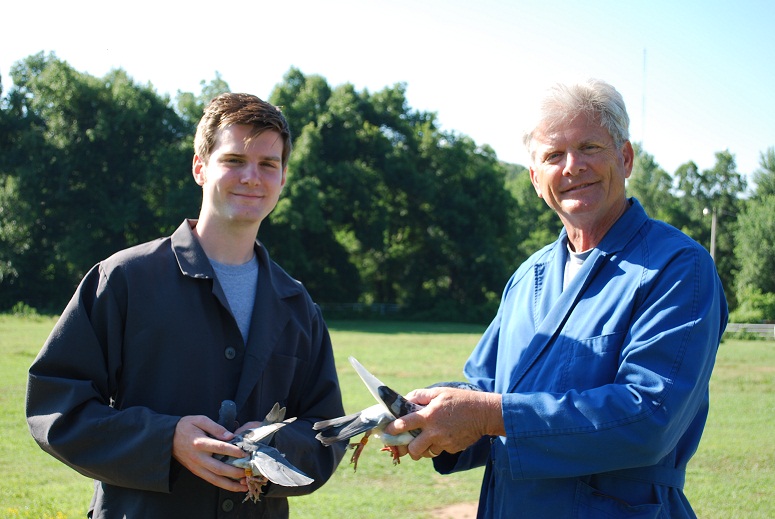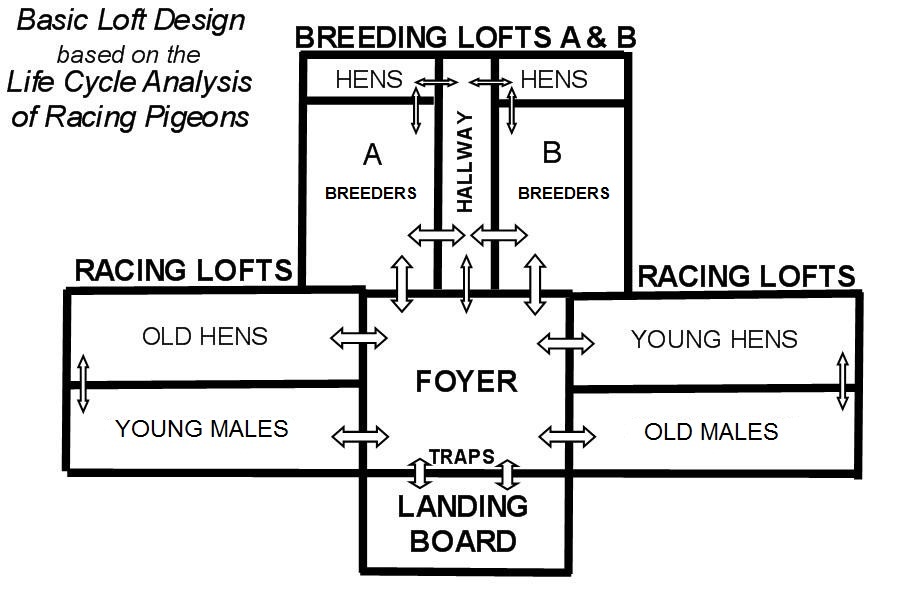 |
Lamberton Racing Pigeons TOP OF THE RACE SHEET Loft Management Series "Basic Loft Design Based on Life Cycle Rotation" |
|
The basic loft design at Lamberton Racing Pigeons reflects the life cycle of racing pigeons. In the beginning, young birds are hatched in the breeding loft - weaned and raced in the young bird loft - moved to the old bird racing loft - and retired to the breeding loft if they have performed well enough to have earned a nest box. At Lamberton Racing Pigeons, this process is called the "life cycle rotation of racing pigeons" during which racing pigeons start their lives and finish their lives in the same breeding section. All pigeons - breeders, young birds or old birds - are released from their sections and re-enter their loft sections through a common room or "foyer." Consequently, all racing pigeons use the same entry and exit for their entire lives. Because the loft is predicated upon the life cycle rotation of racing pigeons, the pigeon loft is actually three lofts or wings combined into one large loft in the shape of a cross. The top of the cross (which is actually at the bottom of the diagram) is used for (1) the landing area, (2) entry area or "trap" (as is said in America) or sputnik (as it is referred to in Europe), and (3) release area. One wing houses young birds. One wing houses old birds. And the wing opposite the landing board houses retired racers that become full-time breeders. (The location of pigeons in the interior wings is arbitrary.) The "A" & "B" wings of the loft are constructed in sections. The exact length of the wings should depend upon the number of sections that you want to construct in each wing; and that depends upon the number of racing pigeons that you want to race. See the second Basic Loft Design picture below. Our loft sections have a thin sliding door constructed between them so that we can walk from loft section to loft section. Wings can also be constructed nine or ten feet wide (rather than six feet wide) to add a three or four feet hallway down the length of the wing and across the front of the loft sections. The hallways will allow fanciers to walk into each loft section without going through another section. However, if a hallway is constructed down the length of each wing, every effort should be made to make sure that the loft wing ventilates properly. As a general rule, the larger, wider and deeper the loft wing and/or loft section - the poorer the ventilation. Based upon our experience in Belgium, our lofts are built like a chimney. Lofts that are constructed only six feet or two meters deep tend to "breathe" or ventilate much better and much more naturally than wider lofts in which the natural air movement is much more stagnate due to the width of the wing. The natural ventilation of each wing and/or loft section should result in a natural gentle and continual exchange of air. Consequently, our loft sections are constructed five feet wide and six feet deep - like chimneys. In addition to ventilation, however, another important reason for building small loft sections is that small sections dramatically increase your ability to control, manage, and train the racing pigeons within the sections. Again, we have been taught in Belgium that loft sections should not be constructed much larger than the area within your arm span when you stand in the middle of a loft section with your arms outstretched and rotate 360 degrees. The height of the ceiling in the loft section should not be higher than six inches above your height. Why? Because the pigeons in each loft section should not be able to fly around, over or past you when you are standing anywhere in the loft section. You should be able to physically dominate and control the movement and behavior of the race birds in each section with your hands, arms and body. When you enter your loft sections, the race birds should remain standing calmly in their nest boxes rather than quickly flying away into another loft section or to the floor or to an open aviary. It is usually much more difficult to teach pigeons a racing system if they are constantly flying and moving away. Stationary and attentive pigeons tend to make better students of the racing pigeon game. We construct nest boxes along the back walls of loft sections. For five feet by six feet loft sections, we construct six nest boxes two boxes across and three boxes down. Each nest box is constructed about thirty inches wide and twenty-four inches deep. (These dimensions fit the wire-based plastic-coated nest box fronts that we have used in the construction of our nest boxes. Nest fronts that are sized or constructed differently from our nest fronts may alter the exact size of nest boxes). EXAMPLE: If you want to race twelve pigeons on widowhood, a loft wing should be constructed in three sections: two sections to accommodate the twelve race birds (six pigeons per section) and one section to house the mates of the twelve race birds (this section should contain twelve perches constructed small enough to discourage coupling of the mates). The breeding loft "C" should be constructed large enough to accommodate a reasonable number of breeders. In general, lofts should face east or south to capture the maximum sunlight of a geographical area and to avoid the afternoon heat of a sun setting in the west. Lofts should seldom face north allowing the winter weather and winds to enter directly into the loft. IMPORTANT: Pigeon lofts should be designed for the ease and comfort of both racing pigeons and racing pigeon fanciers. Comfortable lofts tend to invite and encourage fanciers to spend more time in the loft. Uncomfortable or inefficient lofts tend to discourage fanciers from spending much time in the loft. The Journey to the Top of the race sheet always involves a significant amount of time spent in the loft building relationships with each racing pigeon and teaching the race teams a racing system. |
| Two Simple Versions of the Basic Loft Design Constructed Using the Life Cycle Rotation Principle |


| A Deluxe Version of the Basic Loft Design Constructed Using the Life Cycle Rotation Principle |
|
The deluxe version of the basic loft design allows fanciers to race more pigeons. |
